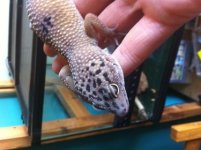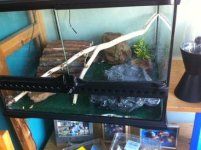hi I was just wondering if my leopard gecko sounds healthy. she is a female, aged just over 1 year now im guessing I've had her since September and not much has changed except its gotten a bit warmer. she has a warm hide which has a underneath a tank exo-terra heat matt ( I will soon replace this as the temperatures don't reach what they say on the dial, they only reach 25 degrees C at max) she has a spagmoss humid cave which is quite cool, and a cool cave, she has a bowl of meal worms and water in her tank which I top up and empty out often, her flooring is leopard gecko carpeting, she is cleaned out once a weak and the carpet is washed and switched, she also has some plastic plants and a small wooden arc to climb.
her behaviour seems strange...
she spends a lot of time in the humid cave which is hidden by the wooden arc for privacy so she isn't in the warm cave for more then 50% of the time, this means she is mostly cold, is this a matter of privacy? or is this normal? if I move the wooden arc over the warm hide would she prefer it? (yes im replacing the heat matt as its a few degrees C off for her)
her eating habits seem lacking, she always has a bowl of mealworms but inly eats one or 2 if set in front of her, she never goes to the bowl and takes them it seems, she also never drinks but im guessing the humid cave sorts that out. I feed her size 4 crickets occasionally dusted with calcium powder, when I fed her the other day she stalked it as geckos do then when she got in range she examined it, nudged it with her nose a few times and walked away, does this mean they weren't big enough? if so do I need to buy the next size up?
she has a little greyish/ whiteish shiny smooth scales on the tip of her nose, hard to see, it looks out of place on her and it looks like damaged scales.
I also sometimes buy wax worms once a month which she always eats, I only feed her 3 at max per week for 2 weeks
I don't know the measurements of the tank but its seems the right size for her and was recommended but may be a little bit stuffy, I would like to avoid taking pictures as it takes a long amount of time to get them onto my laptop but I will do if needed.
please tell me if she is ill or just the way geckos act sometimes
btw her name is treecko
her behaviour seems strange...
she spends a lot of time in the humid cave which is hidden by the wooden arc for privacy so she isn't in the warm cave for more then 50% of the time, this means she is mostly cold, is this a matter of privacy? or is this normal? if I move the wooden arc over the warm hide would she prefer it? (yes im replacing the heat matt as its a few degrees C off for her)
her eating habits seem lacking, she always has a bowl of mealworms but inly eats one or 2 if set in front of her, she never goes to the bowl and takes them it seems, she also never drinks but im guessing the humid cave sorts that out. I feed her size 4 crickets occasionally dusted with calcium powder, when I fed her the other day she stalked it as geckos do then when she got in range she examined it, nudged it with her nose a few times and walked away, does this mean they weren't big enough? if so do I need to buy the next size up?
she has a little greyish/ whiteish shiny smooth scales on the tip of her nose, hard to see, it looks out of place on her and it looks like damaged scales.
I also sometimes buy wax worms once a month which she always eats, I only feed her 3 at max per week for 2 weeks
I don't know the measurements of the tank but its seems the right size for her and was recommended but may be a little bit stuffy, I would like to avoid taking pictures as it takes a long amount of time to get them onto my laptop but I will do if needed.
please tell me if she is ill or just the way geckos act sometimes
btw her name is treecko





